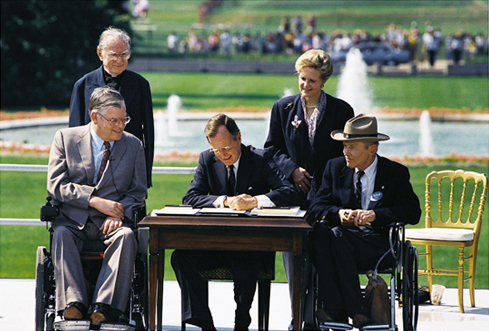In 1973, President Richard Nixon made significant advancements in equality for individuals with disabilities by signing the Rehabilitation Act of 1973. This was the first official law aimed at protecting people with disabilities. While it was an important step towards equality, the law was open to interpretation, which led to legal challenges regarding the protections it offered. Although the act made considerable progress, it did not fully address discrimination against people with disabilities. To expand on the protections provided by the Rehabilitation Act, a new law was proposed, which formed part of the platform on which George H.W. Bush campaigned. On July 26, 1990, President George H.W. Bush signed the Americans with Disabilities Act (ADA) into law.
The Americans with Disabilities Act (ADA) is a civil rights law that prohibits discrimination against individuals with disabilities. It ensures that all individuals, regardless of their disabilities, are provided with equal opportunities and benefits. Under this act, employers are required to make reasonable accommodations for all employees, which includes considerations in hiring, firing, promotion, and training. Additionally, the ADA mandates that public facilities, such as restaurants, hotels, and stores, must be accessible to individuals with disabilities. It also requires that transportation systems, including buses and subways, be accessible.
The signing ceremony for the ADA, held on the South Lawn of the White House, was regarded as a momentous event. Key figures in the fight for disability rights attended the ceremony, including Evan Kemp, Chairman of the Equal Employment Opportunity Commission, and Justin Dart, Chairman of the President’s Committee on Employment for People with Disabilities. This act is considered the most important advancement in disability rights legislation and in the effort to dismantle discrimination against people with disabilities.

